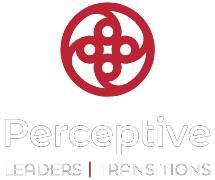
Challenge:
A small and emerging midmarket company had experienced explosive sales growth as an innovative newcomer in the market. The CEO and company Founder had worked together since the inception of the company. The company had recently received outside investor funding to fuel taking the business to the next level. Additional leadership positions had recently been created, including functional VP’s, all of whom now reported to the CEO.
Perceptive was brought into the company to support the CEO in his role as Chief Executive. This was the first startup he had been involved in and he was new to being at the helm of leading a fast-growing organization.
Every leader will need to evolve their leadership if they are to be effective leading a growing organization in an ever-changing landscape.
The senior team reporting to the CEO described multiple challenges including the loss of top talent in key positions which was disruptive for the business.
Solution:
Executive Coaching for the CEO
Perceptive began by working with the CEO in an Executive Coaching capacity. As with all executive coaching engagements, we sought to learn more about his vision for the company, his perspective on the challenges the business was facing, and the leadership challenges he was experiencing.
With a keen intellect and as a savvy businessperson, it was evident that the CEO was in many ways what the organization needed in the startup phase of its trajectory.
We worked with the CEO to customize an Executive Coaching Program for him. This included utilizing a self-assessment tool that would provide insights into his personality preferences and how those translated into his leadership style. We selected the Myers-Briggs Type Inventory (or MBTI) instrument as a best fit for the organization.
We agreed that it would be important to obtain 360-degree feedback on how others in the organization experienced his leadership. He had never worked with an executive coach before or received this kind of 360-degree feedback. He expressed apprehension but could see why it was important and moved forward in a trusting partnership with his coach.
At Perceptive, we understand that working with an executive coach and receiving feedback is new for many top leaders. It takes a desire to learn and evolve as leader alongside trust in the coach to move forward.
We conducted an extensive interview-based 360-degree feedback process with key stakeholders. This gave the CEO insight into perceptions of his leadership, including his leadership strengths and areas where he was seen as less effective. The feedback revealed several strengths and areas where he was being less effective along with the downside impacts on the organization.
Organizational Assessment
We recommended an Organizational Assessment be completed in parallel with the CEO coaching. This assessment was designed to provide a broader perspective on, and deeper insight into, the organizational problems they were facing as a company. Confidential interviews were conducted with key stakeholders across the organization and aggregated into Key Findings and Recommendations.
Decision-making and the Senior Team
Themes began to emerge early in the Organizational Assessment. A key finding was that many decisions were being made by the CEO and/or the Founder without input from the senior team. They were frustrated by critical issues being decided in a vacuum, not being addressed in a timely manner, or at all.
Many attributed this in large part to the Founder’s tendency to make unilateral decisions and the CEOs inability or unwillingness to address the problem. With so many key decisions held at the top, slowed, or not being made at all, this was having a crippling effect on the organization.
Organizational Structure and Key Leadership Roles
Lack of role clarity in key leadership positions resulted in confusion and inefficiency throughout the organization.
For an organization to scale effectively, decision-making needs to move deeper into the organization where the success of the business will increasingly reside.
These two organizational findings, in combination, were strongly contributing to the company’s inability to retain newly hired top talent and, importantly, to move the organization forward in critical ways if the business was to position itself to effectively scale for continued growth.
Areas of Focus in the Coaching to Create the Biggest Impact
Three areas of focus were identified as having the greatest potential impact for this top leader. These included relinquishing tight control in areas that initially served the organization but were now limiting it, learning to include and lead his senior team more effectively, and doing something the CEO found personally challenging: dealing with interpersonal conflict. This meant he would need to have the difficult conversations.
His coach also helped him look at where he was focusing his time and energy and the amount of time he was spending at work. He had a strong work ethic, and when combined with having a lot invested in the business, he took little time away. He had been burning the proverbial candle on both ends for years and it was coming at a high cost for him personally.
Results:
Over the next six months the CEO made good progress in some areas including involving his senior team more, while continuing to struggle in dealing with conflict. He found it incredibly difficult to engage in conversations where it may mean dealing with the strong emotions of others.
Importantly, he had begun to curb the amount of time he was spending at work. This gave him the time he needed to reflect on the situation and discern what was best for him and for the organization.
CEO and a President or Co-CEOs
The CEO decided to hire a President to take on responsibility for several aspects of leading the company. This included operational oversight of day-to-day operations. The Founder would report to the President which was a significant change. The addition of a President role would allow the CEO to focus more on strategy and working with the Board and investors. It would also create a potential pathway to succession in the CEO role.
At Perceptive, we find that such a structure at the top requires exceptional alignment between the two positions. In this case, the CEO would need to support the President in making critical operational and organizational decisions. Such alignment would also be particularly important considering the initial presenting issue which was the inability to retain people in key leadership positions.
Leader Transitions in the CEO Role
A year later, the CEO discerned that it was time for him to step down. With the President now solidly in place, and able to scale his leadership into the CEO role, it was time for a change.
Perceptive as asked to work with the two leaders to support a successful succession for the organization. The CEO was an important face of the company and it would be important to consider this in the transition planning.
We supported the President, as he transitioned into the CEO position. To be successful, he needed to give up day-to-day operational management and move into a more strategically focused role. We supported the exiting CEO, as he gave up the CEO reigns and began to envision a post-career life.
The transition to the new CEO was a smooth one for both leaders and for the organization.
A year later, the incoming CEO was firmly established, and along with his senior team, had made decisions that effectively positioned the company to scale effectively into the future. By all accounts, the exiting CEO had made the right decision to step down and the new CEO was a good choice to lead the organization into the next phase of its evolution.
Note: To honor the confidentiality and protect the privacy of our clients we do not use names and have altered possibly identifying details in this Case Study.
About Perceptive Leaders LLC
Perceptive is a boutique leadership development and professional transitions consulting firm based in Denver, Colorado serving clients in the US and Canada, since 2005. We have worked with over 1,000 senior organizational leaders and accomplished career professionals to help them recognize opportunities for impactful and substantive change and how to realize that transformational change. For more than 15 years, Perceptive has been helping leaders and their teams transform their leadership. For more information, visit perceptiveleaders.com.
© Perceptive Leaders, 2022. All rights reserved.




